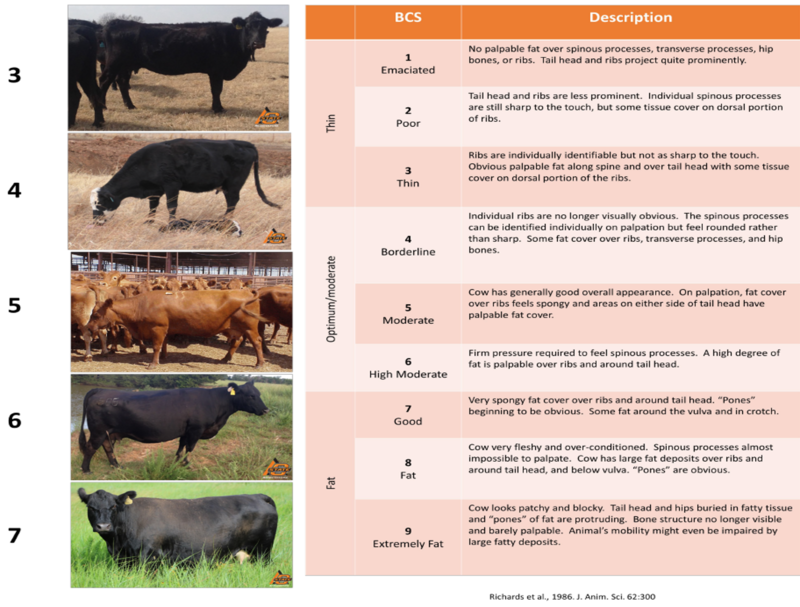Enhanced comment feature has been enabled for all readers including those not logged in. Click on the Discussion tab (top left) to add or reply to discussions.
Body Condition Scores: Difference between revisions
No edit summary |
No edit summary |
||
| (3 intermediate revisions by 2 users not shown) | |||
| Line 1: | Line 1: | ||
[[Category:Management/Convenience Traits]] | |||
[[Category: Data Collection]] | |||
Body condition scoring (BCS) is a useful tool to estimate the body composition and energy reserves of beef cows. The BCS scale ranges from 1-9 with 1 being emaciated and 9 being obese. Cows that calve in a BCS of 5 or greater breed back earlier, have more vigorous calves at birth and have more, higher quality colostrum. Ideally, scores should be recorded 60-90 days pre-calving, at calving and at weaning. Taking scores at 60-90 days pre-calving allows enough time for adjustment of the nutrition program prior to calving if necessary. | Body condition scoring (BCS) is a useful tool to estimate the body composition and energy reserves of beef cows. The BCS scale ranges from 1-9 with 1 being emaciated and 9 being obese. Cows that calve in a BCS of 5 or greater breed back earlier, have more vigorous calves at birth and have more, higher quality colostrum. Ideally, scores should be recorded 60-90 days pre-calving, at calving and at weaning. Taking scores at 60-90 days pre-calving allows enough time for adjustment of the nutrition program prior to calving if necessary. | ||
Scores recorded at or around the time of weaning are used in combination with cow weight recorded at the same time to calculate adjusted mature cow weights. Shrunk body weight should increase or decrease by approximately 7.1% for each unit change in BCS | Scores recorded at or around the time of weaning are used in combination with cow weight recorded at the same time to calculate adjusted mature cow weights. Shrunk body weight should increase or decrease by approximately 7.1% for each unit change in BCS <ref>National Academies of Sciences, Engineering, and Medicine. 2016. Nutrient Requirements of Beef Cattle: Eighth Edition. Washington, DC: The National Academies Press. https://doi.org/10.17226/19014 </ref> . For example, a mature cow that weighs 1,200 pounds with a BCS of 5 should require 85 pounds of weight gain to achieve BCS 6 and 85 pounds of weight loss to drop to a BCS of 4. | ||
<center> | <center> | ||
[[File: BCS2.png|800px]] | [[File: BCS2.png|800px]] | ||
</center> | </center> | ||
Latest revision as of 13:05, 2 June 2022
Body condition scoring (BCS) is a useful tool to estimate the body composition and energy reserves of beef cows. The BCS scale ranges from 1-9 with 1 being emaciated and 9 being obese. Cows that calve in a BCS of 5 or greater breed back earlier, have more vigorous calves at birth and have more, higher quality colostrum. Ideally, scores should be recorded 60-90 days pre-calving, at calving and at weaning. Taking scores at 60-90 days pre-calving allows enough time for adjustment of the nutrition program prior to calving if necessary.
Scores recorded at or around the time of weaning are used in combination with cow weight recorded at the same time to calculate adjusted mature cow weights. Shrunk body weight should increase or decrease by approximately 7.1% for each unit change in BCS [1] . For example, a mature cow that weighs 1,200 pounds with a BCS of 5 should require 85 pounds of weight gain to achieve BCS 6 and 85 pounds of weight loss to drop to a BCS of 4.
- ↑ National Academies of Sciences, Engineering, and Medicine. 2016. Nutrient Requirements of Beef Cattle: Eighth Edition. Washington, DC: The National Academies Press. https://doi.org/10.17226/19014
